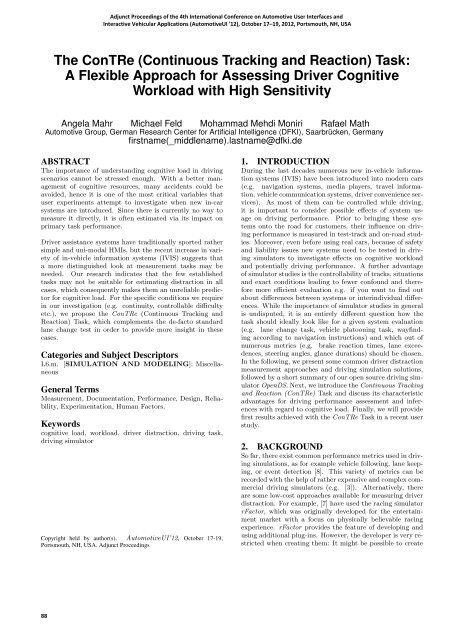12: Adjunct Proceedings - Automotive User Interfaces and ...
12: Adjunct Proceedings - Automotive User Interfaces and ...
12: Adjunct Proceedings - Automotive User Interfaces and ...
Create successful ePaper yourself
Turn your PDF publications into a flip-book with our unique Google optimized e-Paper software.
The ConTRe (Continuous Tracking <strong>and</strong> Reaction) Task:<br />
A Flexible Approach for Assessing Driver Cognitive<br />
Workload with High Sensitivity<br />
Angela Mahr Michael Feld Mohammad Mehdi Moniri Rafael Math<br />
<strong>Automotive</strong> Group, German Research Center for Artificial Intelligence (DFKI), Saarbrücken, Germany<br />
firstname(_middlename).lastname@dfki.de<br />
ABSTRACT<br />
The importance of underst<strong>and</strong>ing cognitive load in driving<br />
scenarios cannot be stressed enough. With a better management<br />
of cognitive resources, many accidents could be<br />
avoided, hence it is one of the most critical variables that<br />
user experiments attempt to investigate when new in-car<br />
systems are introduced. Since there is currently no way to<br />
measure it directly, it is often estimated via its impact on<br />
primary task performance.<br />
Driver assistance systems have traditionally sported rather<br />
simple <strong>and</strong> uni-modal HMIs, but the recent increase in variety<br />
of in-vehicle information systems (IVIS) suggests that<br />
a more distinguished look at measurement tasks may be<br />
needed. Our research indicates that the few established<br />
tasks may not be suitable for estimating distraction in all<br />
cases, which consequently makes them an unreliable predictor<br />
for cognitive load. For the specific conditions we require<br />
in our investigation (e.g. continuity, controllable di culty<br />
etc.), we propose the ConTRe (Continuous Tracking <strong>and</strong><br />
Reaction) Task, which complements the de-facto st<strong>and</strong>ard<br />
lane change test in order to provide more insight in these<br />
cases.<br />
Categories <strong>and</strong> Subject Descriptors<br />
I.6.m. [SIMULATION AND MODELING]: Miscellaneous<br />
General Terms<br />
Measurement, Documentation, Performance, Design, Reliability,<br />
Experimentation, Human Factors.<br />
Keywords<br />
cognitive load, workload, driver distraction, driving task,<br />
driving simulator<br />
Copyright held by author(s). <strong>Automotive</strong>UI’<strong>12</strong>, October 17-19,<br />
Portsmouth, NH, USA. <strong>Adjunct</strong> <strong>Proceedings</strong><br />
88<br />
<strong>Adjunct</strong> <strong>Proceedings</strong> of the 4th International Conference on <strong>Automotive</strong> <strong>User</strong> <strong>Interfaces</strong> <strong>and</strong><br />
Interactive Vehicular Applications (<strong>Automotive</strong>UI '<strong>12</strong>), October 17–19, 20<strong>12</strong>, Portsmouth, NH, USA<br />
1. INTRODUCTION<br />
During the last decades numerous new in-vehicle information<br />
systems (IVIS) have been introduced into modern cars<br />
(e.g. navigation systems, media players, travel information,<br />
vehicle communication systems, driver convenience services).<br />
As most of them can be controlled while driving,<br />
it is important to consider possible e↵ects of system usage<br />
on driving performance. Prior to bringing these systems<br />
onto the road for customers, their influence on driving<br />
performance is measured in test-track <strong>and</strong> on-road studies.<br />
Moreover, even before using real cars, because of safety<br />
<strong>and</strong> liability issues new systems need to be tested in driving<br />
simulators to investigate e↵ects on cognitive workload<br />
<strong>and</strong> potentially driving performance. A further advantage<br />
of simulator studies is the controllability of tracks, situations<br />
<strong>and</strong> exact conditions leading to fewer confound <strong>and</strong> therefore<br />
more e cient evaluation e.g. if you want to find out<br />
about di↵erences between systems or interindividual di↵erences.<br />
While the importance of simulator studies in general<br />
is undisputed, it is an entirely di↵erent question how the<br />
task should ideally look like for a given system evaluation<br />
(e.g. lane change task, vehicle platooning task, wayfinding<br />
according to navigation instructions) <strong>and</strong> which out of<br />
numerous metrics (e.g. brake reaction times, lane exceedences,<br />
steering angles, glance durations) should be chosen.<br />
In the following, we present some common driver distraction<br />
measurement approaches <strong>and</strong> driving simulation solutions,<br />
followed by a short summary of our open source driving simulator<br />
OpenDS. Next, we introduce the Continuous Tracking<br />
<strong>and</strong> Reaction (ConTRe) Task <strong>and</strong> discuss its characteristic<br />
advantages for driving performance assessment <strong>and</strong> inferences<br />
with regard to cognitive load. Finally, we will provide<br />
first results achieved with the ConTRe Task in a recent user<br />
study.<br />
2. BACKGROUND<br />
So far, there exist common performance metrics used in driving<br />
simulations, as for example vehicle following, lane keeping,<br />
or event detection [8]. This variety of metrics can be<br />
recorded with the help of rather expensive <strong>and</strong> complex commercial<br />
driving simulators (e.g. [3]). Alternatively, there<br />
are some low-cost approaches available for measuring driver<br />
distraction. For example, [7] have used the racing simulator<br />
rFactor, which was originally developed for the entertainment<br />
market with a focus on physically believable racing<br />
experience. rFactor provides the feature of developing <strong>and</strong><br />
using additional plug-ins. However, the developer is very restricted<br />
when creating them: It might be possible to create





